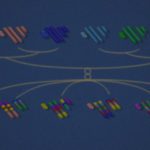Link to Pubmed [PMID] – 15677551
Am. J. Physiol. Gastrointest. Liver Physiol. 2005 Jun;288(6):G1208-16
Erythropoietic protoporphyria is an inherited disorder of heme biosynthesis caused by partial ferrochelatase deficiency, resulting in protoporphyrin (PP) overproduction by erythrocytes. In humans, it is responsible for painful skin photosensitivity and, occasionally, liver failure due to accumulation of PP in the liver. The ferrochelatase deficiency mouse mutation is the best animal model available for human erythropoietic protoporphyria. The original description, based on mice with a BALB/cByJCrl genetic background, reported a disease resembling the severe form of the human disease, with anemia, jaundice, and liver failure. Using congenic strains, we investigated the effect of genetic background on the severity of the phenotype. Compared with BALB/cByJCrl, C57BL/6JCrl mice developed moderate but increasing anemia and intense liver accumulation of PP with severe hepatocyte damage and loss. Bile excretory function was not affected, and bilirubin remained low. Despite the highest PP concentration in erythrocytes, anemia was mild and there were few PP deposits in the liver in SJL/JOrlCrl homozygotes. Discriminant analysis using six hematologic and biochemical parameters showed that homozygotes of the three genetic backgrounds could be clustered in three well-separated groups. These three congenic strains provide strong evidence for independent genetic control of bone marrow contribution of PP overproduction to development of liver disease and biliary PP excretion. They provide a tool to investigate the physiological mechanisms involved in these phenotypic differences and to identify modifying genes.

